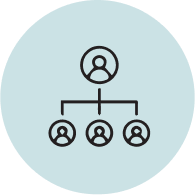ERP Selection Guide
Top Ten ERP Questions to Ask, ERP Selection FAQ, Guide and Requirements Checklist
Expert advice on selecting the right ERP system for your business in April 2025
Selecting an ERP system requires careful consideration and research. Informed by 25+ years of experience in the software industry, our team has compiled a list of helpful steps to help you in the process of selecting an ERP system that best fits your business.
Discover the Best ERP Systems to Modernize and Streamline Your Business Operations
- Learn how leading ERP systems can transform your business through unified financials, CRM, inventory and operations.
Avoid Common ERP Implementation Challenges
- With a 100% success rate in implementation, Protelo project managers share their "secret sauce" for a smooth implementation.
Create the Perfect ERP Selection Checklist
- Develop a comprehensive checklist to select the best cloud-based ERP for your business needs.
Compare Leading Cloud ERP Platforms
- Evaluate top cloud ERP solutions like Oracle NetSuite, Acumatica and more. Learn industry trends like generative AI.
Choose the Right ERP Partner
- Find a reliable and experienced partner to successfully implement your ERP system.
Establishing Selection Criteria
Effective ERP selection starts with establishing the selection criteria early on—including core business requirements that take into account changing business needs, future growth and the correct ERP capabilities native to the platform.
Key steps to take:
- Assess and document the current state.
- Create a clear and concise list of requirements and opportunities.
- Collaborate with leadership and core users to refine and prioritize these requirements.
- Prepare documentation to support and present the findings to your ERP partner and to aid in ERP research.
ERP tip: Finding an ERP with industry-specific advantages and features built in, such as NetSuite for Manufacturing or Acumatica for Construction is a competitive advantage.
Avoid Common ERP Implementation Challenges
A successful ERP implementation strategy consists of planning and preparation, configuration and data migration, testing and training to meet your planned go-live date.
The implementation involves working with your consultants to define business needs, customize the software, migrate data, integrate with other systems, provide user training, conduct testing, and ensure a smooth go-live.
The duration and complexity vary depending on the organization, but a successful implementation requires careful planning, collaboration, and post-implementation support.
The following elements are key in almost any ERP implementation are:
- Discovery
- Design
- Configuration
- Integration
- Data conversion
- Training
- Testing
Read our Complete Guide to ERP Implementation
Expert Tip: On average, a NetSuite or Acumatica implementation takes 50 – 150 hours to dig deep into the the initial requirements phase. ERP partners bill $150.00 – $300.00 an hour, so a thorough investigation and discovery in-house will save your company time and money before you even start the implementation.
Establishing Selection Criteria
Effective ERP selection starts with establishing the selection criteria early on—including core business requirements that take into account changing business needs, future growth and the correct ERP capabilities native to the platform.
Key steps to take:
- Assess and document the current state.
- Create a clear and concise list of requirements and opportunities.
- Collaborate with leadership and core users to refine and prioritize these requirements.
- Prepare documentation to support and present the findings to your ERP partner and to aid in ERP research.
ERP tip: Finding an ERP with industry-specific advantages and features built in, such as NetSuite for Manufacturing or Acumatica for Construction is a competitive advantage.
Avoid Common ERP Implementation Challenges
A successful ERP implementation strategy consists of planning and preparation, configuration and data migration, testing and training to meet your planned go-live date.
The implementation involves working with your consultants to define business needs, customize the software, migrate data, integrate with other systems, provide user training, conduct testing, and ensure a smooth go-live.
The duration and complexity vary depending on the organization, but a successful implementation requires careful planning, collaboration, and post-implementation support.
The following elements are key in almost any ERP implementation are:
- Discovery
- Design
- Configuration
- Integration
- Data conversion
- Training
- Testing
Read our Complete Guide to ERP Implementation
Expert Tip: On average, a NetSuite or Acumatica implementation takes 50 – 150 hours to dig deep into the the initial requirements phase. ERP partners bill $150.00 – $300.00 an hour, so a thorough investigation and discovery in-house will save your company time and money before you even start the implementation.
Checklist: Key Questions to Ask When Selecting an ERP System
1. Business Requirements
- Does the ERP system specifically support my industry - i.e. Acumatica for Construction and NetSuite for Distribution, Manufacturing and Construction?
- Does the ERP system match my specific business requirements we noted in our internal discovery?
2. ERP Features & Functionality
- Is the user interface easily used and intuitive?
- Is there a mobile app for on-the-go access?
- What reports, KPIs are included?
- Can new features/modules be added as my business grows?
3. Total Cost of Ownership and ROI
- How much will the ERP system cost?
- How is the software licensed?
- What does the pricing include?
4. System Integration
- Does the ERP system integrate with other business systems?
- How easily can existing data be migrated into the ERP system?
5. User Adoption, Training and Post Go-Live Support
- What level of support is provided during implementation and after?
- Is employee training provided?
6. Implementation
- How long will implementation take?
- What is your implementation methodology?
- What will my team do vs. yours?
7. Vendor Industry Expertise
- How well does the provider know my industry?
- How long has the vendor been doing ERP implementations?
- Are they certified in their respective ERP?
9. Vendor Product Roadmap
- What new features are planned and when will they be released?
- Does the vendor publish updates on a known schedule?
- Is there an additional charge to upgrade to the new features or move my customizations over to an upgrade?
- Is there new technology, such as generative AI?
10. Customization
- Can the ERP system be customized?
- What support for customization is provided?
Protelo - Big Enough to Deliver, Small Enough to Care
Now that you are armed with the beginnings of an efficient ERP software evaluation—from the selection criteria, to the questions to ask, to the common pitfalls—it's time to look at a your ERP software options.
Our Solutions
.png?width=178&height=42&name=NetSuite-logo-half-light%20(1).png)
Protelo is a trusted, award-winning ERP consultancy that partners with the top two cloud ERPs in the world: Oracle NetSuite and Acumatica ERP. We can help you choose the best path for your business.
With Protelo You Receive:

Direct Access
to ERP Experts

On-Demand Support
and Best Practices

Pay As You Go
ERP Services
The Protelo Difference
A top-tier partner behind the NetSuite and Acumatica products.
WHAT SETS PROTELO APART? Protelo is more than just a software team; we are an extension of your business and committed to your growth and success with every interaction. The benefit of working with Protelo is that we are small enough to care yet big enough to deliver. Protelo is a full-service team of business, technology, and development experts based in the United States.
Protelo business consultants have deep experience—an average of 15+ years each—across industries and verticals such as wholesale distribution, manufacturing, services, and more. We strive to become a trusted extension of your company and invested in your success.
Related Guides & Blogs:

1. Top Benefits of NetSuite
Learn why companies are moving to NetSuite cloud ERP in 2025. Learn the many benefits of Oracle NetSuite ERP, including flexible pricing, scalability for your business, and key core integrations.
2. What is Acumatica?
Explore Acumatica, a top Cloud ERP system. Discover its features, modules, pricing, and benefits. Find answers to all your Acumatica questions.
3. The Pros & Cons of ERPWhat is NetSuite ERP?
Essential ERP questions, business tips, and trends for a comprehensive guide to evaluating software. Gain valuable insights for informed decision-making.
